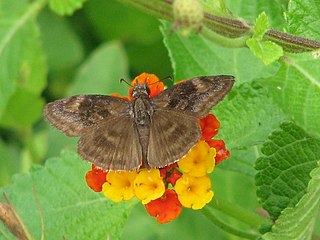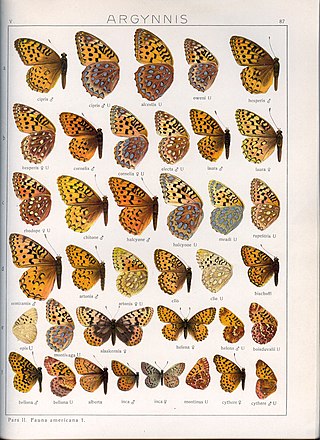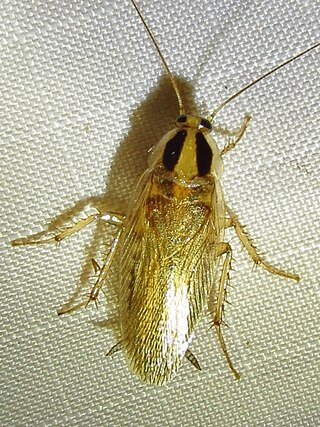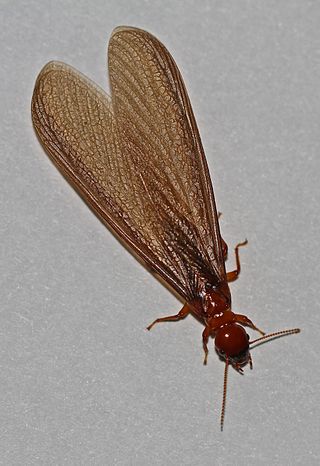
Parcoblatta virginica, the Virginia wood cockroach, is a small cockroach species of the genus Parcoblatta, measuring about a centimeter long as an adult.

The Turkestan cockroach, also known as the rusty red cockroach, red runner cockroach or simply rusty red, red runner, or lat, is a primarily outdoor-dwelling cockroach native to an area from northern Africa to Central Asia. Adults measure around 3 cm (1.2 in) in length. Adult males are a brownish orange or red, are slender, and have long, yellowish wings which allow it to attract females and to glide. Adult females are dark brown to black, with cream-colored markings on the shield and a cream-colored stripe edging its wings; they are broader than males, and have short vestigial wings. Nymphs are brown in front, black on the rear, and are wingless.

Parcoblatta bolliana, Boll's wood cockroach or Boll's wood roach, is a small species of wood cockroach native to the United States, measuring around 11 mm (0.43 in) long.

Ectobius lapponicus, also known as the dusky cockroach, is a species of cockroach found in Europe, northern Asia, the northeastern United States, and southeastern Canada.

Plagiognathus is a genus of plant bugs in the family Miridae. There are at least 110 described species in Plagiognathus.

Buprestis langii is a species of metallic wood-boring beetles in the family Buprestidae. It is found in North America.

Drepanulatrix hulstii is a species of geometrid moth in the family Geometridae. It was described by Harrison Gray Dyar Jr. in 1904 and is found in North America.

Eunica monima, the dingy purplewing, is a species of tropical brushfoot in the family Nymphalidae, and was described by Caspar Stoll in 1782. It is found in North America.
Atrytonopsis pittacus, the white-barred skipper, is a species of grass skipper in the family Hesperiidae. It was described by William Henry Edwards in 1882 and is found in Central and North America.

Gesta invisus, the false duskywing, is a species of spread-wing skipper in the family Hesperiidae. It was described by Arthur Gardiner Butler and Herbert Druce in 1872 and is found in Central and North America.

Plectoptera picta, the pictured beetle cockroach, is a species of cockroach in the family Ectobiidae. It is found in Central America and North America.

Plectoptera is a genus of American cockroaches in the family Ectobiidae and tribe Plectopterini. There are at least 2 described species in Plectoptera.
Agathymus baueri, or Bauer's giant-skipper, is a species of giant skipper in the family Hesperiidae. It is found in North America.

Lon taxiles, the taxiles skipper, is a species of grass skipper in the family Hesperiidae. It is found in Central America and North America.

Chlosyne definita, known generally as the definite patch or definite checkerspot, is a species of checkerspot in the family Nymphalidae. It is found in North America.

Boloria alaskensis, the mountain fritillary or Alaskan fritillary, is a species of fritillary butterfly in the family Nymphalidae. It was described by William Jacob Holland in 1900 and is found in North America and North European Russia. The MONA or Hodges number for Boloria alaskensis is 4462. The larvae feed on false bistort and alpine smartweed.

Blattella vaga, the field cockroach, is a species of cockroach in the family Ectobiidae. It is found in Europe and Northern Asia, Central America, North America, and Southern Asia.

Blattoidea is a superfamily of cockroaches and termites in the order Blattodea. There are about 17 families and more than 4,100 described species in Blattoidea.

Archotermopsidae is a family of termites in the order Blattodea, known as dampwood termites, formerly included within the family Termopsidae. They constitute a small and rather primitive family with two extant genera and 5 living species. They may rarely infest structures but do not usually do so, nor do they cause extensive damage to buildings or other man-made structures unless said structure has been sufficiently damaged such as by water. As their name implies, they eat wood that is not dried out, perhaps even rotting, and consequently of little use to humans.

















